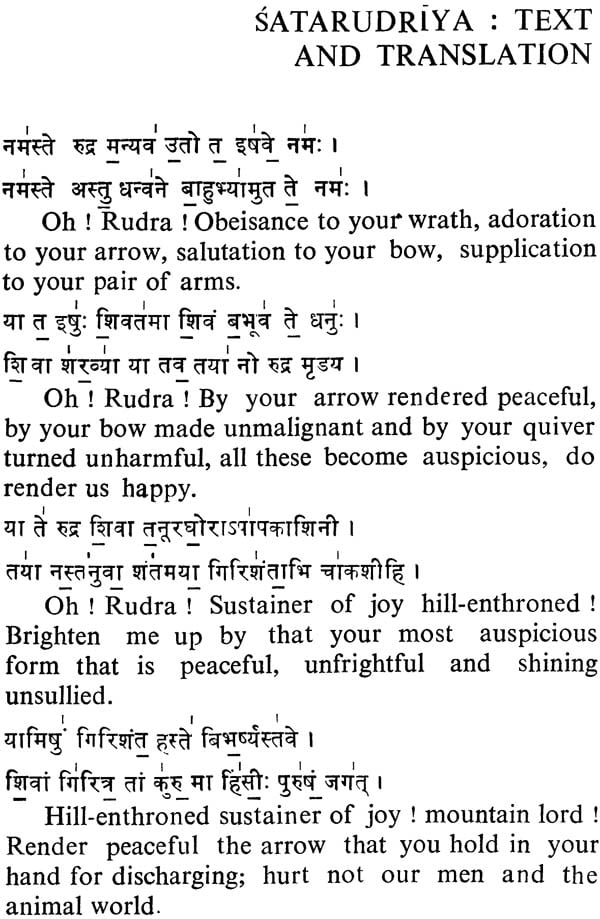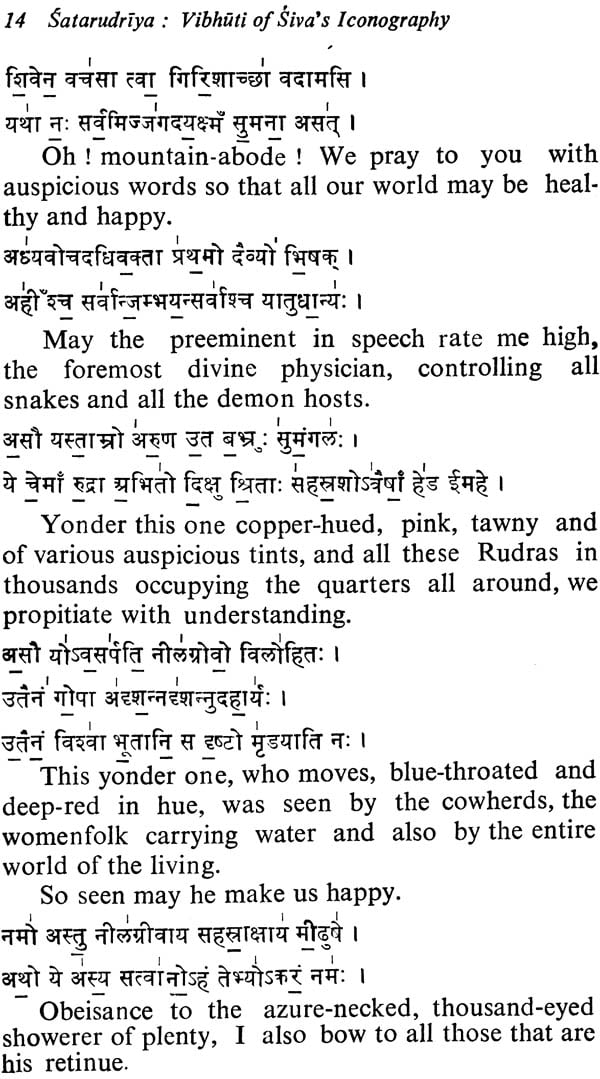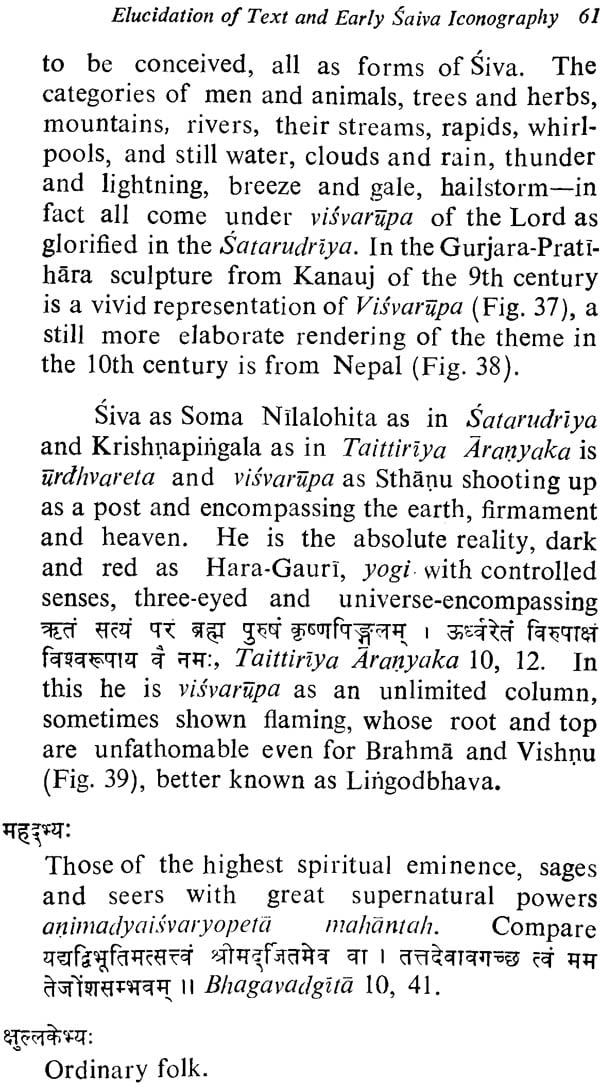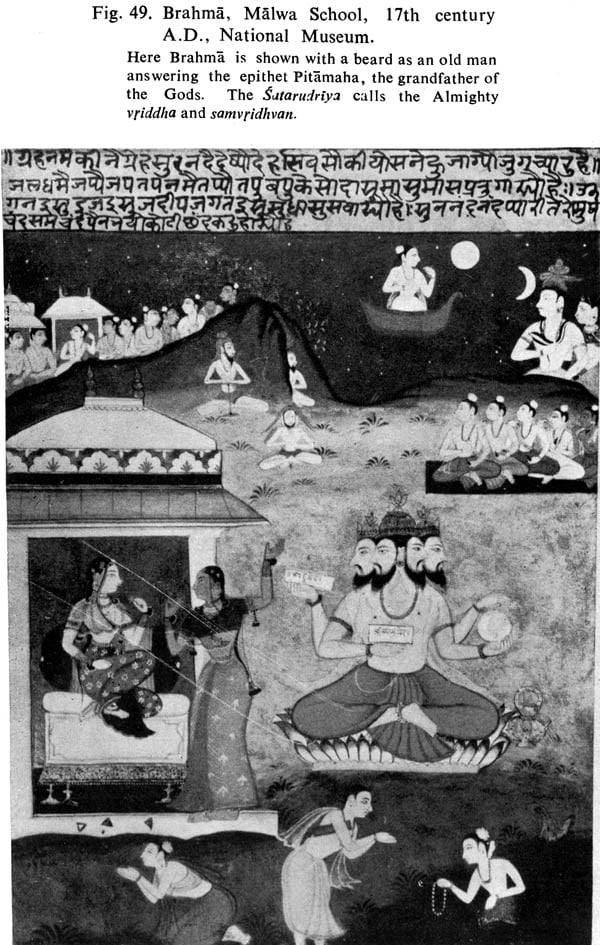
'Satarudriya': Vibhuti of Sivas Iconography (An Old and Rare Book)
Book Specification
| Item Code: | IDE319 |
| Author: | C. Sivaramamurti |
| Publisher: | ABHINAV PUBLICATION |
| Language: | English |
| Edition: | 2022 |
| ISBN: | 9788170170389 |
| Pages: | 144 (B & W Illus: 67) |
| Cover: | Hardcover |
| Other Details | 8.8" X 5.8" |
| Weight | 510 gm |
Book Description
From the Jacket:
The present book on 'Satarudriya : Vibhuti of Siva's Iconography' is not only the text from the Krishnayajurveda Taittiriya Samhita with its translation but is a discussion of the epithets and their significance in the context of the iconographic concepts associated with Siva and the importance of this Vedic text in understanding the immanence of the Almighty conceived as Rudra. These discussions are illustrated by a bunch of chosen examples of art that form the plates accompanying the text.
About the Author:
After a brilliant academic career C. Sivaramamurti entered the Museum profession as Curator for Archaeology in the Madras Museum. He then joined the Archaeological Survey of India as Superintendent, Archaeological Section, Indian Museum, Calcutta, whence he came over to the National Museum as Keeper and rose as Assistant Director and finally became the Director. Closely associated with the International Council of Museums he was in its executive committee and was Chairman of the Indian National Committee of ICOM.
An Honorary Fellow of the Royal Anatic Society of Great Britain and Ireland, he is the recipient of Padmabhushan award from the President of India. His Holiness Jagadguru Sri Sankaracharya of Kanchi has blessed him with the title Vichitrachitta.
He was offered the Jawaharlal Nehru Fellowship to make an intensive study of the Nataraja theme. He was also Honorary Adviser on Museums for Government of India.
He has been responsible for popularizing epigraphy and numismatics, sculpture and painting from an approach through literature giving literary parallels. His love for Sanskrit and art, his aesthetic taste and capacity to draw, paint and sculpt helped him to achieve his purpose of such a study of art and literature.
He has traveled widely all over the world, participated in international seminars, delivered important lectures at the invitation of several universities which have been published as books. He has over thirty-four books and innumerable papers on sculpture, painting, architecture, iconography, epigraphy, numismatics and literature to his credit. His large and profusely illustrated book 'L art en Inde' now available in French and German will shortly appear in Spanish, Italian and English. His 'Nataraja in Art, Thought and Literature' is encyclopaedic on the theme.
The Satarudriya, included in the Krsnayajur- veda Taittiriya Samhita, is one of the most impor- tant holy hymns of the Hindu religion; its recital has the power of cleansing all sins; it extols Rudra as the Godhead in its infinite appearances and as- pects, Visvarupa, the Power which is at the same the creator and the destroyer, the rhythm of life and death, the supreme healer of the ills of samsara, the supreme yogin; he is represented alone or with the paredra Uma, the All, the supreme conscious- ness. Prof. Sivaramamurti, with his unparalleled knowledge of Hindu literature edits and translates the texts of the Satarudrrya, comments upon it and often refers to some images which are inspired by the famous hymn itself. Hindu images are not only an expression of the devotion of the believer, but also the representation through plastic or painted figures of a tremendously rich and multi- farious theological and philosophical background. When we are confronted with a Hindu image we are not only admiring its aesthetic values, but we are deciphering a symbol in which are concentrated centuries old intuitions: an image is a book in which primitive glimpses of universal archetypes are exalted into bold metaphysical systems and devotional mystic ecstasies; Indian art does not express things but sublime ideas, complex medita- tions, flashing intuitions. The statue of a god is the reflex of spiritual tensions; each part of it, its posture, the different objects which the god displays in his arms, the gesture of the hands, all that has a meaning; it is a way to approach the mystery to which they lead the devotee. The anjali before them is the first step, krama, which should, by increasing' meditation, reveal to us the truth which is behind the form, and it leads gradually to liberation, kramamukti when we have grasped, what do I say, not only grasped but possessed, the full significance of the truth which absconds itself in that temporary appearance. Thus it is evident that those who do not know the key, so to say, that opens the door of those experiences are bound to remain in samsara: without this key the contemplation of an image would be only a bahirangapariksa. Very few can compete with Prof. Sivaramamurti, who is a great historian of Indian art, it is true, but a great scholar who knows the philosophical and theological trea- sures of Indian Mind. That is why his writings are so attractive; he is a great authority on history of Indian art, but his unlimited knowledge of Indian speculation makes him an interpreter of the real pregnance of the images which he displays before our eyes. In so doing he introduces ourselves to the mysterium magnum which is beyond the visible. If one reads Satarudriya commented by him one will understand what I have briefly summarized in this short introduction.
In a certain way it becomes a prayer book for everybody because the splendour of the infinite epiphanies of Siva are common to all human inter- pretations of Godhead in the infinite lila of His manifestations.
Nothing to wonder about it; Sivaramamurti is like those princes descending from generations of kings, who through centuries preserved and increased the heritage of the great forefathers: in his blood there is the blood of Appayya Diksita his ancestor, and of an uninterrupted series of generations which made of the Sanskrit culture the very reason of their life, up to his father who wrote also one Mahakavya. Miracles which only in India can now be found, lives dedicated to the defence and to the enrich- ment of a marvellous synthesis of devotion and reasoning, of meditation and logical speculation, of mystical surrenders and of the monolithic archi- tecture of the metaphysical systems. The Satarud- rtya is a book in which one finds the fervour of a great aesthetic feeling and the unfathomable depths of an unsurpassed learning.
Namas Sivaya, Sivataraya ca.
From the days of my boyhood when I used to listen to my father's melodious chants of the Yajurveda in which he was erudite, both in intona- tion in recital and its depth of meaning. I had conceived a fascination for both Namaka and Chamaka. Even stories, that my father used to narrate for us children, when we asked for them in the evenings, would be stories from the Yajurveda if it were not the story of Rania, which he was never tired of repeating and we of listening. Father's erudition in English literature was equalled only by his prodigious learning in Sanskrit, Classical and Vedic. His keen sense of justice (dharma) as a magistrate was equalled only by his immaculate ethical mode of life (dharma) in the Vedic tradition where he almost set a model.
It was my misfortune that I lost my father as a boy of eleven, a few months after my upanayann ceremony, and I, who could have completed tD adhyayana of all the Kandas of Krishnayajurveda Taittiriya Samhita from my father, had to seek possible avenues at least for the study of the upayu- kta portions like Namaka, Chamaka, Purushasukta , ' Srisiikta, Mantrapushpa, Taittiriyopanishad, Nara ya- niya Yajhikyupanishad etc., with their proper into- nation, svara.
At that time I used to feel overwhelmed by the grandeur of the concept of Siva in the Namaka or the Satarudriya as the universal spirit immanent in all. The commentaries by Sayana, Bhattabhaskara and Abhinava Sankara would thrill me. When as a student of our beloved Professor Mahamahopadh- yaya S. Kuppuswami Sastri, I was studying Udayana's Kusumanjali and noticed how he eulogis- ed Satarudriya and Purushasukta as the Vibhuti chapters of the Veda like the Vibhuti adhyaya of the Bhagavadgita, I thought I should elucidate these portions of the Veda with visual illustrations from art.
Later, destiny assigned for me in life the place of an interpreter of art and iconography rather than of a teacher of Sanskrit Sastraic texts. This has made possible for me to do the upasana of the Lord through art interpreted through texts.
I took up the Satarudriya soon after I had written at some length on the fascinating theme of Nataraja in Art, Thought and Literature' and have given glimpses of the earliest concepts of Siva in iconography as repeated in the Satarudriya, copiously illustrating my text with illustrations from well-known and sometimes not too well-known sculptures, bronzes, terracottas, paintings etc.
The illustrations for this book are through the kind courtesy of the Archaeological Survey of India, the National Museum, the Madras Museum, the Bangalore Museum, the Prince of Wales Museum of Western India and the Archaeological Department of Tamil Nadu, to all of which I am grateful.
I am most thankful to Miss Vanaja and Mrs. Puri, Deputy Keeper and Technical Assistant res- pectively for Numismatics, National Museum, for preparing the Index and to Mr. Shakti Malik for the special attention which he has bestowed on the production of this book.
I cannot adequately express my -gratitude to that great Seer and Savant in the field of Sanskrit Lear- ning, Art and Culture, Professor Giuseppe Tucci, for graciously blessing me with his inspiring Fore- word and exhorting me to pursue my cultural studies.
I hope this book would serve to stimulate interest in a great and noble theme of Siva immacu- late, Siva that is Sivatara Whom Sruti itself adores by its innumerable namovakas, both directly and indirectly, addressing them not only to Him but also to His weapons and even moods
as Nilakantha Dikshita puts it.
| Foreword by Professor Giuseppe Tucci | vii |
| Preface | xi |
| Introductory | 1 |
| Satarudriya : Text and Translation | 13 |
| Elucidation of Text and Early Saiva Iconography | 33 |
| Bibliography | 108 |
| List of Illustrations | 113 |
| Index | 123 |
| Plates 1-68 | |















